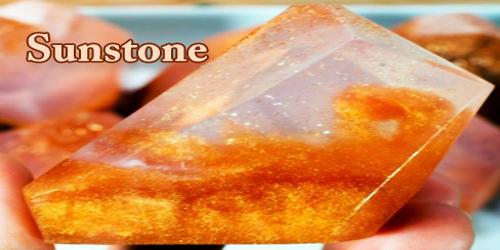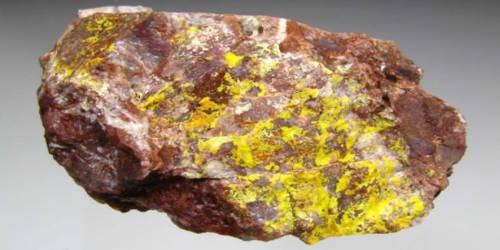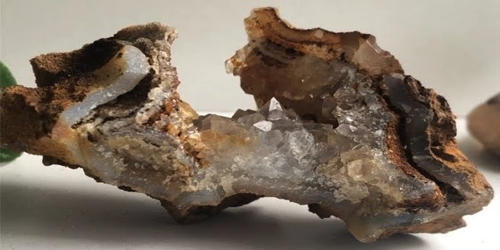Definition –
Sunstone is an abundance stone which is a member of the Feldspar family. These mineral inclusions usually have a common orientation, and light entering the stone reflects from them at a common angle. It produces flashes of light caused by an optical phenomenon called “aventuresence.”
The first materials to be called “sunstone” because of their aventurescence were specimens of oligoclase, a plagioclase feldspar. As other types of feldspar with a strong aventurescence were discovered, the name was also applied to them. Labradorite feldspar (another plagioclase) and orthoclase feldspar have both been found with strong aventurescence.
Sunstone is a stone for leaders, enhancing organizational skills and the ability to act in accord with higher will. Sunstone will help people to get enthusiastically to work and stop procrastination. If people are a pleaser, carry sunstone to help themu learn how to say “no” and learn to set healthy boundaries. It helps to clear emotional hooks found in one’s aura and chakra system. By clearing these hooks, sunstone can restore energy and help people move on from old attachments.
Sunstone is also known as “heliolite” and more commonly “aventurescent feldspar.” It is cut into cabochons, beads, and small sculptures. The most transparent pieces are used to produce faceted stones.
It is popular with innovative jewelry designers and is especially popular in the geographic areas where it is commercially mined. It is not a gemstone that is seen in every jewelry store, and many jewelry buyers have never witnessed its aventurescence. However, once a person is given a demonstration of sunstone’s aventurescence, they often want to try it and are fascinated. It is a gemstone that sells best if the jeweler takes a moment to educate the buyer about aventurescence.
The ancient Greeks believed Sunstone was a magical talisman to attract prosperity and good health. Helps the immune and autonomous nervous systems, throat, cartilage, muscles, and joints.
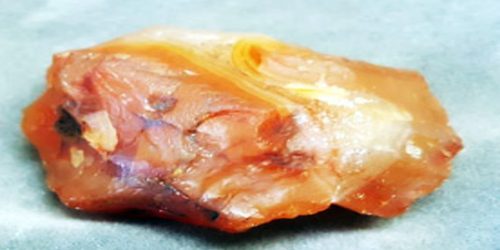
Occurrence and Properties of Sunstone –
Sunstone has been found in Southern Norway, Sweden, various United States localities and on some beaches along the midcoast of South Australia. The most famous sunstone deposits in the United States are located in Oregon. A few of the sunstone deposits in Oregon are large enough to sustain mining operations. They are found in certain basalt flows in Lake County and Harney County. There the sunstone occurs as phenocrysts within the basalt. Some sunstone is produced from the weathered zone above the basalt flows, and some is produced from the basalt. Other locations include near Lake Baikal in Siberia, and several United States localities notably at Middletown Township, Delaware County, Pennsylvania; Plush, Oregon; and Statesville, North Carolina.
The Oregon basalt flows that contain sunstone are located mainly on public land, and many productive or promising areas are held by mining claims. The U.S. Bureau of Land Management has reserved one area in Lake County as a public collecting area where anyone can enter, look for sunstone, and keep what they find for personal use. Collectors must follow BLM’s collecting rules and stay off of adjacent lands where mining claims have been registered. Collecting on land with an active mining claim can only be done with the owner’s permission.
The optical effect appears to be due to reflections from inclusions of red copper, in the form of minute scales, which are hexagonal, rhombic, or irregular in shape, and are disposed parallel to the principal cleavage-plane. These inclusions give the stone an appearance something like that of aventurine, hence sunstone is known also as “aventurine-feldspar”. The optical effect called schiller and the color in Oregon Sunstone is due to copper. The middle part of this crystal sparkles, and usually the color is darkest in the middle and becomes lighter toward the outer edges.
The feldspar which usually displays the aventurine appearance is oligoclase, though the effect is sometimes seen in orthoclase: hence two kinds of sunstone are distinguished as “oligoclase sunstone” and “orthoclase sunstone”.
This stone is associated with Cancer, Moon in Aries, Moon in Cancer, Moon in Capricorn, and Moon in Pisces. Sunstone occurs in a range of colors that begins with colorless and ranges through yellow, orange, and red. The color is determined, in part, by the abundance and size of the copper platelets within the stone. The copper platelets impart a pink or reddish color to the stone. Some exceptional stones are deep green or blue in color.
A variety known as Oregon sunstone is found in Harney County, Oregon and in eastern Lake County north of Plush. Oregon Sunstone contains elemental copper. Oregon Sunstone is unique in that crystals can be quite large. The copper leads to variant color within some stones, where turning one stone will result in manifold hues: the more copper within the stone, the darker the complexion.
In the case of sunstone, the metallic inclusions are usually copper, but can also be hematite or the mineral goethite. It is the flatness of the inclusions that give the appearance of glitter, but that also means the cut of the stone matters in how much light gets reflected off of the metal platelets. Sunstone is transparent to translucent and sits at a 6 on the Mohs hardness scale.
In the early 2000s, a new variety of red or green gemstone resembling sunstone and known as ‘Andesine’ appeared in the gem market. After much controversy and debate, most of these gemstones, allegedly sourced from China, were subsequently discovered to have been artificially colored by a copper diffusion process. A Tibetan source of bona fide (untreated) red andesine, however, was eventually verified by a number of independent groups of well-respected gemologists.
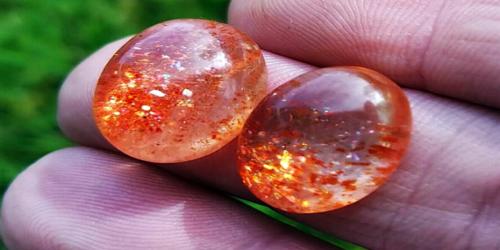
Uses and Benefits of Sunstone –
Sunstone is an orange to reddish-brown variety of feldspar with sparkling metallic inclusions. This sparkle effect is sometimes called aventurescence and is also exhibited by aventurine and the manufactured glass called ‘goldstone’. Consequently, sunstone is sometimes called, “aventurine feldspar”.
Sunstone is not often seen in jewelry stores in most parts of the world. It is mainly used by innovative jewelry designers and those who enjoy surprising customers with interesting pieces. The small amount of sunstone entering the market as calibrated stones has limited its use in mass-production jewelry.
“Oregon Sunstone” is now a very popular gemstone in Oregon, where most people have heard of it. Many people who visit Oregon go home with a piece of Oregon Sunstone jewelry, and this spreads the word about sunstone to other areas.
This stone is associated with the base, sacral, and solar plexus chakras. It has the ability to cleanse and activate all chakras. People can place this stone in full moon moonlight to energize. It can also be moved through sage smoke or incense, placed in rice, or buried in the earth over night. The warmth of this stone is said to aid the metabolism and digestive system. It can also help aches and pains around the body.
Sunstone provides a source of strength if people are dependent on others emotionally, or have suffered the sudden loss of a partner. It helps alleviate fearfulness and stress, and protects against those who drain their energies or finances. It is also an excellent crystal for phobia sufferers to ease fear of the dark, enclosed places, or the presence of other triggers.
Sunstone is also synonymous with benevolent leadership, imbuing the qualities of healthy masculine energy. It encourages fair, empowering leadership that is motivated by being of service to the greater whole, rather than seeking power over others. Its energy is of benevolence and cooperation, of wanting to serve and support each individual for the benefit of the whole.
Sunstone honors Cerridwen, the Welsh Goddess of Inspiration and Knowledge. She rules the gifts of prophecy and magic, and powers death and rebirth. She is the guardian of spiritual transformation. It may also be used to honor Sekhmet, the Egyptian Goddess of War. She is the most powerful goddess of Lower Egypt, and is usually depicted with the head of a lion and the body of a beautiful woman.
Information Sources:
